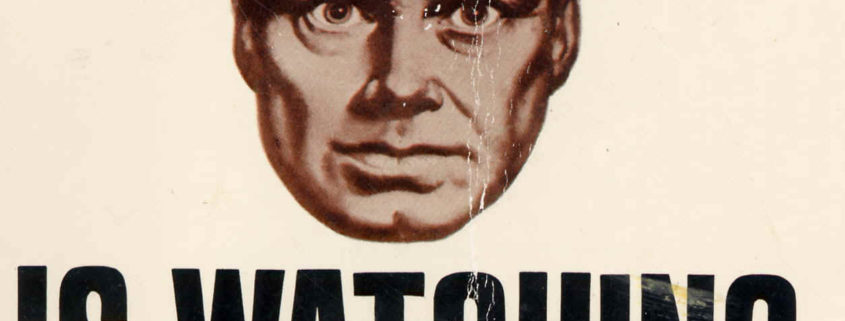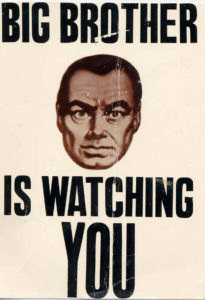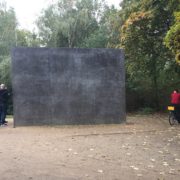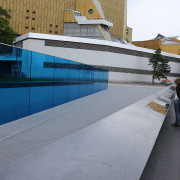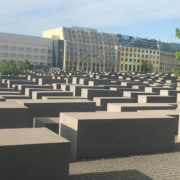The Rise of Totalitarianism: East Berlin Through the Lens of George Orwell’s 1984
By Eric Weisansal
I never quite understood why most of all high schools used George Orwell’s 1984 as a required reading until I visited Hohenshönhausen, a memorial at the site of a former East German political prison. Reading the text and deciphering it previously in my education made the whole visit a lot more meaningful and thought provoking. Yes, the visit itself was extremely moving, especially having a tour guide who was a primary source of information to lead you through the sight of his own oppression. The Soviet rule in East Berlin exemplifies a society in which there are no secrets, which total control is laid down up on the citizens and anything which may be seen as anti-government can have extreme consequences. All the main ingredients necessary for a classic novel to be written that contains many dystopian ideologies, meanings, and everlasting historical metaphors are present.
Following the collapse of Nazi Germany after the Second World War, the victors divided the country into four sectors. Three of the zones fell under democratic influences of Britain, United States and France, while the fourth zone was controlled by the communist Soviet Union. Although, there was a special little island within the Soviet’s sector of the divided country. This island was Berlin and, like Germany, the city was also split; there was West Berlin, governed by the democratic countries, and there was East Berlin, ruled by the communist Soviet Union. The East and West sides of Berlin were extremely different. The west was where citizens were granted their core democratic rights, including freedom of speech and movement, luring East Berliners who were robbed of those rights to emigrate to the west. People would leave East Berlin for work, and to shop on a daily basis. West Berlin also served as a way out. By the early 1960s, Soviet controlled East Berlin realized that people were using West Berlin as a port of exit to western Europe, risking a loss of all their talented, skilled workers. East Berlin needed these people to stay in the east to run a functioning society, so the Soviets did what they felt necessary in order to keep these people in their state. They built a wall; this enclosing of West Berlin brought the dystopian society in to the East.
George Orwell’s 1984 was written in the year 1948, which is before the Berlin Wall was raised. This is what confuses me so much about the similarities between the dystopian society portrayed within the novel and the society that was in East Berlin, because at least to me, it seems as if George Orwell wrote this book as a direct metaphor to East Berlin. For those who may have not had the pleasure to read the literary piece, the story is about a society that is watched over by “Big Brother” a man who is in charge of the society and who sees and hears everything. There would be television type devices installed in all homes and buildings which have a camera, allowing “Big Brother” to watch your every move and listen to every conversation. The main character would often cram himself in to a corner of his home in order to not be seen by “Big Brother” just so he could write in his journal. There are not many people you can trust to talk about the government, or any disagreements you have with what is happening, because you never knew who would report you because the whole society was basically brainwashed to think a certain way. Also, once you were caught, you would be taken to a government facility which you were tortured in order to fit yourself in to and believe in the society. Even while writing this it’s tough to differentiate whether I’m talking about 1984 or life in East Berlin.
While visiting the Stasi prison, we learned from Lothar Schultz, a former prisoner of that very place, about how life was in East Berlin, and in the prison itself. I found the stories and history to be eerily similar to Orwell’s 1984. He told us of how when people were taken by the Stasi, it was hard to know how you were “caught” because the Stasi were very good at secret;ly installing surveillance devices in homes without any knowledge of the residents. Other citizens were also known to report people to the Stasi very frequently as well. Many of the people surrounding you in everyday life, may have been spying on you, something proved by our tour guide Lothar Schultz. After the fall of the Berlin wall, citizens were able access their secret police files to learn about how the Stasi had an eye on all aspects of people’s lives. The only information concealed in the files were the names of paid Stasi informants. Schultz had explained the reasoning behind the names being hidden and how a spy often turned out to be a spouse, neighbor, family member or someone else close who had reported you. To put in perspective how much could be written about someone like Lothar Schultz, a government engineer, to date he is aware that his file contains around 1,500 pages.
In 1984, the protagonist, who was also a government worker, was taken in to the government facility after being reported on by his boss. So far, the only difference that I can find between the novel and the real-life situation is that in 1984 everyone knew they were being watched by “Big Brother” while in East Berlin it seemed to be one of the only secrets that was able to be kept. The lack of privacy is extremely prominent in the regime of both societies. Lothar Schultz then explained how prisoners, were often tortured physically, and always being tortured mentally. They would be placed in tiny cells with nothing but a bucket, a wooden bed which you were barely allowed to sleep in, and four very close walls. People would do anything to get out of these small cells which included eating springs and other small metal items just to go to the hospital and see something besides the walls that enclose them. The torture which reminds me most of that which was in 1984, and which I found extremely frightening was being placed in the cell which was the circular room, which had no light and nowhere to relieve yourself. He explained how when in complete darkness, the first human instinct is to feel for corners in order to map out the room you’re in and get an idea for how much space you have. But, in this room that such thing was impossible, and would drive you mad. The reason that it reminds me most of 1984, is that the torture which was used on the protagonist involved his worst fear, rats, which they discovered by watching his reaction to seeing rats in life before he was captured. In comparison to the dark, circular room, instead of going to their worst fear, they went to the most basic needs and instincts of a human mind in order to drive them mad.
The Society portrayed in George Orwell’s 1984, I believe is metaphorical for the regime ruling over East Berlin post 1945, which is why I believe that 1984 is so relevant still today. It teaches us about the realities and struggles of daily life in East Berlin and behind the Berlin Wall. It’s truly a scary thought of how anyone can live like this, inside or outside the prison. Visiting the Stasi prison gave me a new perspective on freedoms which are a part of the foundation of the United States and the democratic system which sometimes may be taken for granted, a new respect for George Orwell’s 1984 and an extremely large respect for people like Lothar Schultz. His view on life coming out of the prison, how he dealt with it and most importantly, how he learned from the experience and grew from it is beautiful.

